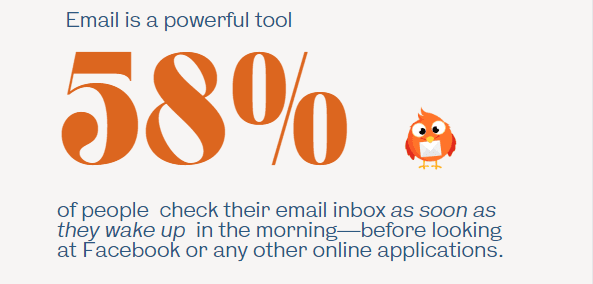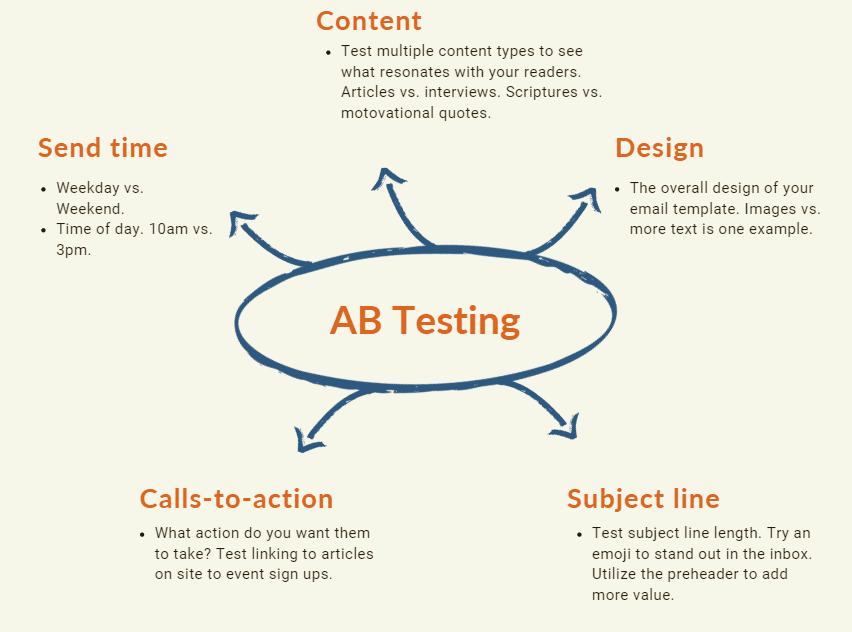Communicating by email is still one of the easiest ways for organizations to connect with members and new visitors. However, if your church uses email without any strategy, you miss out on an excellent opportunity to streamline communication and engage with your congregation. When done right, email programs can tremendously impact your church’s overall communication plan.
This strategy should include goals for your church email campaigns and how you’ll execute the campaigns and measure success. With a well-designed plan, church email programs can be a powerful tool for promoting your church or religious organization.
Research has shown that email reaches more people than social media or any other channel. According to Agency Analytics, people tend to check their email more frequently than they do social media, which is why you need to get strategic about the types of emails you put in front of your audience.

6 reasons why you need an email strategy for your church
1. Inexpensive and easy to use:
Email is the perfect way to communicate with your church members. The initial setup is quick and learning how to use an email platform is relatively simple, allowing you to get your first email campaign sent in just a few hours. Some email platforms like Robly offer special discounts or low-tier pricing for faith-based organizations.
2. Measurable results
Measuring the success of your email campaigns can seem like a tall order when you are just getting started. However, the benefits of one-to-one communication that email provides becomes very evident within a few campaigns. Analyzing key performance indicators (KPIs) quickly becomes second nature. Most email platforms offer you enough data to make informed decisions about what works best for engaging audiences with content they want.
It’s crucial to determine what metrics matter the most and ensure it syncs up with your overall goals. Clicks, opens, event signups, email address captures, etc., are a few KPIs most email marketers evaluate after each send. Check out this short video below from Robly that explains reporting basics and see how easy the platform is to navigate.
Email is personal
Strategic personalization results in more relevant content being served to your audience.
For example, it’s unnecessary to send a newsletter dedicated to Sunday school for kids to churchgoers who do not have any children. Blasting emails to your full list can come across as insensitive and can cause your unsubscribe rate to climb. Take the time to gather the proper data on your audience upon sign up to ensure the best email experience.

Email lists are invaluable
Followers on social media is susceptible to algorithm changes and require constant engagement to ensure even half of your followers even see your posts. Your followers can grow exponentially overnight and be completely unresponsive the next week.
An email address is a relational asset that you own. No one can take that away from you (unless the user decides to unsubscribe on their own). So use your social platforms to engage with followers, but also take the opportunity to utilize the social channels to build your list. That way, if social media disappeared overnight or algorithm changes made it impossible for your social posts to get impressions, you still have all your subscriber information and can continue sending them communications.
You control your content, tone and messaging entirely
With email, you are the author and curator of your newsletter. After getting to know your audience and analyzing the results of past campaigns, you will have a strong understanding of what types of content you should share. Unlike social media you control the messaging that is shared, and you make sure the right information is in front of the right audience.

Email allows you to be automatically reactive
You can set up simple automated actions like Robly Autoresponders to send reactive messages easily. An autoresponder, for instance, would send a welcome email as soon as someone subscribes to your list. You can also set up a more elaborate sequence of emails that takes your new subscriber on a journey towards your desired end goal.
Now that you have an overview of why building a strategy for your email newsletters is essential; let’s look at how you can execute this strategy.
Successfully execute your church email strategy in 5 easy steps.
Now that you know why you need a church email strategy, what do you need to do to execute that strategy?
Map out goals
You probably have a pretty good idea of what you want to accomplish with your church’s email strategy. But if you don’t take the time to map out your goals and put them on paper, you’ll never be able to measure the success—or determine whether or not you’re achieving those goals.
Mapping out your church email promotion goals doesn’t have to be complicated. Start by asking yourself a few basic questions:
- What are our church’s overall marketing goals? Subscriber growth? More volunteers, more in-person attendance to mass, etc.
- How can email help us achieve those goals? Jot down how you think email can help solve the issue. For example, spreading the word, making it easily accessible for your readers, etc.
- What specific actions do we want our church members to take as a result of receiving our emails? For example, do you want more volunteers, more followers to attend special events within the congregation, etc.?
Once you clearly understand your church’s marketing goals, you can begin developing specific email promotional strategies. These might include increasing event attendance, boosting donations, or growing your church’s online community, as mentioned above. Whatever your goals may be, make sure they are specific, measurable, achievable, relevant, and time-bound (SMART).
With SMART goals in place, you’ll be well on developing a successful church email strategy that helps you achieve your church’s broader marketing objectives.
Build your email list
An email list is the foundation of your email strategy and one of your most valuable assets. It’s a direct link to your congregation and a great way to keep in touch with members and promote your church. But how do you go about building your church email list?
- On-site list growth opportunities: Promote your newsletter through your website with newsletter popups and also include a section in your website footer to allow visitors to sign up seamlessly.
- Social media channels: Create dedicated posts that encourage visitors to sign up for your newsletter and share a little more about the value prop of the newsletter. Describe “what’s in it” for them and why they would want to sign up to receive monthly updates from your church.
- Promote in person: You can do this by handing out flyers and brochures, by talking to people at community events, and by inviting people to church services. Include a signup sheet at the end of the room, when people exit mass briefly speak about the benefits of receiving the newsletter and encourage churchgoers to sign up before leaving.
Create content that people want to read
When creating church email content, always keep the reader in mind. What would they find interesting or valuable? What would make them want to read more? By taking the time to create quality content, you can ensure that your church emails are actually enjoyed by those who receive them.
If you are feeling stuck and looking for content ideas for your newsletter, check out our article on what to include in church newsletters on what types of content you should look to create.
Develop a sending schedule
Strive for a consistent format and frequency, pick the number of times a month or week you want to send emails, and stick to specific days of the week so your subscribers can look forward to your messages. Planning ahead can avoid pitfalls like sending at sub-optimal times, poor quality of content or design and losing the benefit of predictability. There is no need to go too far into the future, mapping it out month by month is a great starting point.
Want to fully optimize your email sending schedule?
At Robly, we have always thought that it would be amazing if you could send a campaign at the exact moment subscribers check their inbox. With Robly A.I., you can do just that.
Rather than send your campaign out to your whole list all at once, it’s “Just-in-Time” Email Delivery.
Spend time testing your email newsletters
To ensure you get the most out of your emails, test your email messages. A/B testing compares two versions of an email newsletter to see which version performs better. Testing different versions of your church newsletter will help you understand what resonates with your congregation.
The testing possibilities are endless, but here are a few quick ideas that you can test in your newsletter:

Final wrap up
A sound email promotional strategy can be a great way to reach out to current and potential members of your congregation. It can also help keep you in touch with those who have already joined your church. Not only is it a cost-effective way to communicate, but it’s a great way to build relationships with the people who matter most to your business.
If you’re interested in learning more about how an email program can benefit your church, contact us today for more information.

